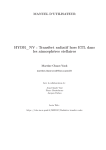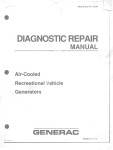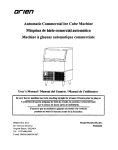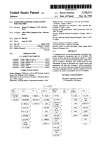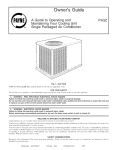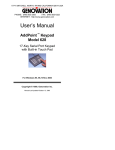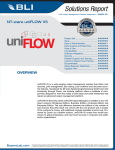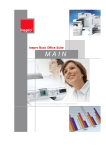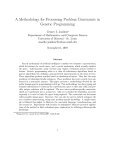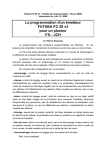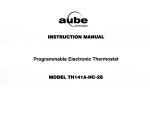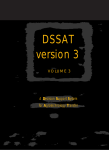Download Computer implemented method
Transcript
US005692233A
United States Patent [19]
[11]
[45]
Garman
‘
5,692,233
Patent Number:
Date of Patent:
Nov. 25, 1997
OMNI, “Model Management System", Haverly Systems.
[54] INTEGRATED SYSTEM AND METHOD FOR
ANALYZING DERIVATIVE SECURITIES
Inc., 1990.
[75] Inventor: Mark B. Garman, On'nda. Calif.
Primary Examiner-Gail O. Hayes
[73] Assignee: Financial Engineering Associates,
Assistant Examiner-Stephen R. Tkacs
Attome); Agent, or Firm—Fenwick & West LLP
Inc., Berkeley. Calif.
[57]
[21] Appl. No.: 384,376
[22] Filed:
Feb. 3, 1995
ABSTRACT
doned.
A system and method for analyzing derivative securities
includes a central processing unit. an input device. an output
device. and a storage. The system includes input and output
routines. a compiler. a sequencer, and a simulator. The input
and output routines generate graphical user interfaces that
[51]
[52]
Int. Cl.6 ............................ .. G06F 17/60; G06G 7/52
US. Cl.
.... .. 705/36; 364/578; 705/35;
allow the user to construct scenarios for simulation. A
scenario includes a set of events that de?ne changes to the
345/339
value of the derivative security over time. The compiler
[58]
Field of Search ................................... .. 364/401. 402,
parses an input scenario and converts it to a low-level
364/406. 408. 419.1, 570. 578; 395/144,
145, 146. 148. 149, 155. 161. 201. 207.
210. 230. 235. 236. 326. 339. 340. 764
executable object. The sequencer then uses the output of the
compiler and other simulation code for a ?nancial Monte
Related US. Application Data
[63]
Continuation of Ser. No. 890,437, May 28, 1992, aban
[56]
Carlo simulation to produce programs executable by the
CPU. The simulator is automatically invoked and runs the
References Cited
executable code using the CPU. The simulator utilizes the
input and output routines to display the results on the display
device. Also disclosed is a method for running the ?nancial
U.S. PATENT DOCUMENTS
5,222,030
5,257,363
6/1993 Dangelo et a1. ...................... .. 364/489
10/1993 Sapiro et a]. ......................... .. 395/500
Monte Carlo simulation that comprises the steps of: input
ting and constructing a scenario. compiling the scenario into
executable code objects. sequencing the code objects with
the simulation code, performing the simulation. and display
U1‘HER PUBLICATIONS
OMN'I (LP Model Management System); Haverly Systems
ing the simulation results on the output device.
Inc; Release Feb. 1977; Dialog (?le 256 01015829).
Professional Dynamo Plus 3.1; Pugh-Roberts Associates
Inc; Release Jun. 1987; Dialog (?le 256 01245216).
=-
15 Claims, 7 Drawing Sheets
SCENARtOt UNTITLED
TIME
GENCALC
v A
PAYCON
PAYOFF
Z
N
ABSCON
A
Y:=MAX(O,
1
BASEDATE() XPRICEO-
+MONTH()
360);
.
Z
Z:=(Y>0)
BASEDATEO
2 +MONTH0.3
3
TRUE()
MAX(0 *
éspoalcEo-
TRUE()
v
US. Patent
Nov. 25, 1997
Sheet 1 of 7
5,692,233
12
32
/
INPUT DEVICES
OR KEYBOARD
I
18
10
f.)
_
14
f1
/
CENTRAL
MASS
STORAGE
<~>
DISPLAY
PROCESSING
—>
DEVICE
UNIT
A
16
rJ
INTERACTIVE
/
20
DISPLAY CONTROL<
MEANS
SIMULATION
MEANS
>
I22
‘
’
SEQUENCING f
MEANS
INPUTAND
28
<—J——>
OUTPUT
RouTINEs
/
COMPILING
I26
MEANS
OPERAT'NG
SYSTEM AND
OTHER RouTINEs
FIG. 1
24
f30
US. Patent
Nov. 25, 1997
Sheet 2 of 7
USER CONSTRUCTS AND
5,692,233
J 50
INPUTS SCENARIO
I
COMPILE ALGEBRAIC
f 52
OPERATIONS TO EXECUTABLE
CODE OBJECTS
I
SEQUENCE NEWLY COMPILED
f 54
CODE OBJECTS WITH
SIMULATION CODE
I
PERFORM SIMULATION BY
f 56
EXECUTING SEQUENCED CODE
I
OUTPUT SIMULATION RESULTS f 58
TO DISPLAY MEANS
FIG. 2
US. Patent
Nov. 25, 1997
Sheet 3 of 7
USER INPUTS AND SAVES A
SCENARIO
I
PARSE PARAMETERS PASSED
BY GUI (SCENARIO FILE NAME,
ITERATIONS TO RUN,
CUMULATION FLAG)
I
RETRIEVE SCENARIO FILE FROM
MASS STORAGE MEANS AND
READ FILE HEADER INFORMATION
(FILE TYPE, FORMAT REVISION)
I
READ SIMULATION CONTROL,
MARKET AND PERTURBATION,
AND ASSET PRICE INFORMATION
FROM SCENARIO FILE
I
I
READ EVENT INFORMATION
COMPILE FORMULAE TO LOW
LEVEL EXECUTABLE CODE
OBJECTS
FIG. 3A
I60
5,692,233
US. Patent
Nov. 25, 1997
Sheet 4 of 7
SEQUENCE CODE OBJECTS FOR
EXECUTION IN LEFT-TO-RIGHT,
TOP-TO-BOTTOM ORDER (AS THE
SECURITY WAS SPECIFIED)
I
PASS CONTROL TO SIMULATION
MEANS FOR CODE EXECUTION
I
ADVANCE EXECUTION TO CODE
FOR NEXT EVENT
I
DETERMINE SIMULATED EVENT
TIME OF OCCURENCE
I
EXECUTE MONTE CARLO
SIMULATION TO DETERMINE
ASSET PRICE AND ECONOMIC
CONDITIONS AT EVENT TIME OF
OCCURRENCE
I
CALCULATE VARIABLES SET
FORTH AS GENERAL FORMULAE
AND STORE VARIABLES
FIG. 3B
I66
5,692,233
US. Patent
Nov. 25, 1997
Sheet 5 0f 7
5,692,233
72
DETERMINE VALUE
/73
TRUE
EXECUTE CODE
(TRUE OR FALSE) OF PAYOFF
OBJECTS TO MAKE
CONTINGENCY
CALCULATED PAYOFF
DETERMINE
VALUE (TRUE OR FALSE)
OF ABSORPTION
CONTINGENCY
WRITE CALCULATED VALUES TO I 77
MASS STORAGE DEVICE
I
PASS CONTROL TO GUI FOR
I 78
DISPLAY OF OUTPUT
I
DISPLAY SIMULATION RESULTS / 79
ON REQUEST
FIG. 3C
US. Patent
Nov. 25, 1997
=-
1
Sheet 6 0f 7
5,692,233
SCENARIO1UNTITLED
TIME
23
GENCALC\
PAYCON\
L 42
40
V A
PAYOFF\
L44
ABSCON\ A
L 46
K
48
4
5
6
7
8
9
10
11
V
FIG. 4A
=
SCENARIO1UNTITLED
TIME
GENCALC
PAYCON
v A
PAYOFF
ABSCON
A
Y:=MAX(O,
1
BASEDATEQ XPR|CE()-
+MONTH()
360);
Z
-
*
N
Z
Z:=(Y>0)
MAX(0 1
BASEDATEO
3
v
FIG. 4B
US. Patent
==
Nov. 25, 1997
Sheet 7 0f 7
RESULTS - SCENARIOZ - SEAPCDVI
AVERAGE VALUE
s70. DEVIATION
VALUE:
0.934279
DELTA:
0.476687
0.0146279
0.476667
5.72025
0.0146279
0.175535
0.012188
0.00214751
0.179627
0000492676
-0.0149856
0.0514878
0.000141063
000429065
UNITS:
VALUE:
GAMMA:
THETA:
DAILY:
% ANNUAL:
7
5,692,233
»
NUMBER OF ITERATIONS: 1000
FIG. 5
0.0458901
v OK
ZXCANCEL
‘
5,692,233
1
2
INTEGRATED SYSTEM AND METHOD FOR
ANALYZING DERIVATIVE SECURITIES
result in errors in the simulation. As a result. the iterative
process of re-coding. re-compiling. rte-executing. and
re-reporting frustrates a trader’s ability to act quickly in
response to market opportunities.
Consequently. there is a need for a system and method
that allows the unsophisticated programmer or trader to
perform their own analysis of the derivative securities by
RELATED APPLICATIONS
This is a continuation of application Ser. No. 071890.437
?led on May 28. 1992 now abandoned.
de?ning. creating and running a ?nancial Monte Carlo
BACKGROUND OF THE INVENTION
simulation.
1. Field of the Invention
This invention relates to a system and method for the
rapid assessment of the fair market value and risk charac
teristics of complex ?nancial securities without the need for
SUMMARY OF THE INVENTION
The present invention overcomes the limitations of this a
knowledge of computer programming. sensitivity analysis.
or statistical simulation techniques.
15
prior art by creating an integrated system and method for a
user unsophisticated in computer programming or simula
tion techniques to rapidly execute ?nancial Monte Carlo
2. Description of the Prior Art
The present invention is directed toward an improved
method for assessing the fair market value and risk charac
teristics of complex ?nancial securities. a category of ?nan
cial instruments that continues to broaden. Complex ?nan
unit. an input device. an output device. mass storage and
memory means. The memory means preferably includes
cial secmities include. in particular. “derivative products"
input and output routines. compiling means. sequencing
such as options and futures. Derivative securities ?uctuate in
means. and simulation means. The input and output routines
of the present invention produce an interactive data input
means for specifying the terms of derivative securities and
simulations on complex ?nancial securities without use of
intermediaries. The integrated system for analyzing deriva
tive securities preferably comprises a central processing
value on the basis of the price of an underlying asset such as
a precious metal. an agricultural product. or a company’s
common stock. The fair market value and risk characteristics
25
parameters. The compiling means and sequencing means are
of derivative securities depend on the value and price
used to create low-level executable code objects embodying
volatility of the underlying asset.
Banks. brokerages. and other major ?nancial institutions
generally apply simulation techniques to assess the fair
the algebraic operations speci?ed (or implied) by these
30
market value and risk characteristics of derivative securities.
Such techniques simulate changes in the prices of the
underlying assets and other economic conditions over the
life of the derivative security. Simulation techniques are
employed because increasingly complex derivative securi
ties provide various contingencies on various dates. The
35
terms and determine the sequence of execution within the
simulator. The simulation means calculates the desired
results. and the input and output routines are utilized to
display the results on the display device. These features of
the invention make it useful for other purposes. including:
designing new ?nancial instruments. evaluating complex
patterns of cash flow and contingencies. auditing ?nancial
valuations produced by other systems. and “benchmarking”
simulation assesses these contingencies in the context of
asset price changes and economic conditions to determine an
in-house analytic models which are used for the valuation of
derivative securities.
estimated payout.
One preferred simulation technique is the “?nancial
Monte Carlo” simulation. Rather than require that all prob
abilities for economic contingencies be speci?ed
completely. a ?nancial Monte Carlo simulation takes advan
tage of market information (within stated assumptions) and
FIG. 1 is a block schematic diagram of a preferred
BRIEF DESCRIPTION OF THE DRAWINGS
determines its own probability distribution. There are a 45
variety of ?nancial Monte Carlo techniques well known to
those skilled in the analysis of derivative securities. Because
of the complexity of ?nancial Monte Carlo simulation. it
methods of calculating payo?'s. underlying asset(s). and
background assumptions) of the derivative security for cod
ing into the ?nancial Monte Carlo simulation program. as
well as parameters for the behavior of the underlying asset,
interest rates. and so forth. The programmer then typically
codes and compiles the program. and executes the simula
tion. Finally. the programmer presents the resulting statistics
to the trader in a numerical or graphical form which sum
marizes the fair market value and risk characteristics of the
derivative security analyzed.
Unfortunately. this process often leads to breakdowns in
communication between the trader (who is attempting to
convey complex ?nancial terms) and the research statf
programmer (who is required to code the simulation). which
FIGS. 3A. 3B. and 3C are a detailed ?ow chart illustrating
the operation of the preferred method of the present inven
tion;
FIGS. 4A and 4B are graphic representations of the
commonly is implemented in a scienti?c programming
language such as C or FORTRAN by statf programmers
familiar with the technique. rather than by the securities
traders who rely on the results. This requires that the trader
communicate to the programmer the terms (contingencies.
embodiment of the system of the present invention;
FIG. 2 is a ?ow chart illustrating operation of the pre
ferred method of the present invention;
50
display device showing preferred embodiments of the
graphic interface for de?ning and starting a simulation; and
FIG. 5 is a graphic representation of the display device
showing a preferred embodiment of the output of the simu
lation.
55
DESCRIPTION OF THE PREFERRED
EMBODIMENT
Referring now to FIG. 1. a preferred embodiment of the
system of the present invention is shown. The preferred
system comprises a central processing unit (CPU) 10. an
input device 12. a display device 14. an addressable memory
means 16 and mass storage 18. The CPU 10 is coupled to
and controls the display device 14 to produce a variety of
images in response to inputs supplied to the CPU 10 by user
manipulation of the input device 12. The CPU 10 is also
coupled to other sources of information such as mass storage
18 and addressable memory 16 in a conventional architec
5,692,233
3
4
ture. In an exemplary embodiment. the CPU 10 may be a
the derivative security and also improve execution speed of
microprocessor from the ’X86 family produced by IntelTM or
the system. Means are provided to make visible a portion of
the available rows at any given time through the use of a
scrollable window. Each row is termed an “event.” since it
represents information which is concurrent in simulation
time. even though it is evaluated (left to right) in real time.
FIG. 4A shows the display device 14 with the GUI for
the 68000 family produced by Motorola”.
The input device 12 is a conventional type as known in the
art. The input device 12 is preferably a keyboard with a
“mouse” type controller. For example. the input device 12
may include a mouse or track ball. Apointer or mouse cursor
inputting a Scenario producing using the input and output
is produced on the display device 14 to represent the position
of the mouse and corresponding movement. By moving the
routines 24. The ?rst column labeled "I‘lME" 40 is for
inputting a date (or formula for determining a date. down to
the minute on a particular date) on which the corresponding
mouse. a user 32 can point to and manipulate ditferent
objects shown on the display device 14.
event occurs, to be evaluated by the simulation means 22.
The display device 14 is also a conventional type known
in the art. The display device 14 is preferably a raster-type
display used with the CPU 10 in a conventional manner to
produce images of characters generated from codes such as
The event usually involves a possible payment to the holder
of the derivative security. but may also represent any point
in simulated time where calculation or simulated activities
are required. The second column labeled “GENCALC’” 42 is
for inputting the formulae. if any, necessary to determine the
values accessed by concurrent or future events. The third
column labeled "PAYCON" 44 is to input any payoff
ASCII in text mode. The CPU 10 may also create images on
the display device 14 in other conventional ways such as
producing an image from a group of dots or pixels in
graphics mode as in the Windowsm operating system pro
duced by Microsoft“. The display device 14 also operates
20 contingencies. expressed as a variable evaluated as a Bool
ean value. The fourth column labeled “Payoff” 46 contains
a formula to be evaluated by the simulation means 22 in the
event that the payoff contingency is found to occur. repre
in a conventional manner with the input device 12 to
produce a cursor on the display device 14 that indicates the
location where data will be input or the object on the display
device 14 that will be manipulated.
The addressable memory 16 is a conventional type and
senting the amount of the payoff of the derivative product.
The ?fth column labeled “ABSCON” 48 is to contain the
absorption contingency (the formula for determining
preferably includes Random Access Memory (RAM) and
Read Only Memory (ROM). The addressable memory 16
further comprises processing routines, programs and data for
interactive display control 20. For example, the memory 16
includes input device interrupt routines and drivers. The
memory 16 also includes routines for transferring data from
the CPU 10 to the display device 14 and for presentation of
the data on the display device 14. The memory 16 further
includes an operating system and other programs 30 as
conventional in the art.
More particularly. the memory means 16 of the present
invention further comprises routines and means that allow
the unsophisticated user to create and run ?nancial Monte
whether the simulation is to terminate). expressed as a
variable evaluated as a Boolean value. Termination of the
simulation of a derivative security is known as absorption.
30
Each row in the Scenario preferably comprises informa
tion relating to one “Event.” An Event is a point in time at
which a potentially signi?cant scheduled occurrence takes
35
place. Any occurrence which is known to the trader. such as
the payment of a dividend on the underlying asset, or the
evaluation of a contingency, and which might affect the
value of the derivative security can be scheduled as an
Event. Events must be listed in order of the simulated time
of their occurrence.
The fonnulae and variables used to set forth the terms of
Carlo analysis. The memory 16 includes input and output
routines 24. compiling means 26 and sequencing means 28.
the daivative security are expressed in a simple language
and simulation means 22. These routines and means are
capable of being transformed by the compiling/sequencing
advantageously integrated by the present invention into
45
means. In the preferred embodiment. this language is known
as the DerivaTool Expression Language (DEL).
FIG. 43 illustrates an example scenario for a particular
derivative security with two events. The security is a call
option (a right to purchase) on gold in three months at an
?nancial knowledge while unsophisticated in computing or
exercise (or “strike") price of $350 (per ounce). The trader
scienti?c knowledge is able the use the system of the present
invention to run ?nancial Monte Carlo simulations. The 50
would like to know the probable return on this security. three
months from now, to determine its fair market value today.
Since the call option will not be exercised if the market price
system for performing ?nancial Monte Carlo simulations on
derivative securities that only requires the user input the
terms for the derivative security. and its contextual market
information. Thus. a user who is sophisticated in terms of
system of the present invention also provides improvements
in performance that signi?cantly reduce the time required to
of gold on the exercise date is less than $350. the return
might be zero. The call option will be exercised if the market
price of gold exceeds $350 on the exercise date. and the
The input and output routines 24 are used along with the
operating system 30 to create a unique graphical user 55 return on the security will be the difference between the
market and exercise prices. The estimated market price on
interface (GUI) on the display device 14. The GUI is
the exercise date. “xprice( )”, is determined by ?nancial
designed to prompt the user 32 to input any number of
run a ?nancial Monte Carlo simulation.
Monte Carlo simulation. The potential payoff is represented
by the formula “max(0. xprice( )—350)” in the fourth column
scenarios upon which a simulation is to be run. The user 32
is prompted by an interactive display control means 20 to
specify the terms of the security to simulate. This speci?
46 of the row labeled Event 2. In columns three 44 and ?ve
48 of FIG. 4B. the contingencies are forced to true because
the payo?’ is certain and there are no subsequent events to be
evaluated.
cation of terms is known as the “Scenario.” The input and
output routines 24 produce a worksheet of ?ve columns and
several rows. and direct the placement of certain information
in each column through the use of headings at the top of each
column. The unique 5~part event ?eld displayed and used by
the present invention is particularly advantageous because it
provides a means for the user 32 to specify all the terms of
65
This security. however. has an earlier payo?’ contingency
(Event 1) designed to protect the seller of the call option
from a dramatic increase in the price of gold. If the market
price of gold has risen by more than ten dollars ($10) in the
5,692,233
5
?rst month after purchase. the seller will pay the holder of
the call option twice the increase in market price greater than
ten dollars ($10). In other words. if xprice( ) is greater than
$360. the payoff is twice the difference. and the seller’s
obligations are extinguished. However. if xprice( ) is less
than or equal to $360. there is no payoff and the security
behaves as an ordinary call option. The formula for the
relevant difference in price is the familiar one “max(0.
xprice( )—-360)”. To simplify the Scenario. a variable can be
assigned this value. In FIG. 4B. the equation “y:=max(0.
xpricc( )—360)” has been placed in the second column 42. If
6
After the sequencing means 28 produces executable code.
the simulation means 22 automatically mns the executable
code using the CPU 10. The simulation means 22 also
includes data ?les that are used during execution of the
?nancial Monte Carlo simulation. The simulation means 22
executes the code and stores the results in memory 16 or in
mass storage 18. The information can then be utilized by the
input and output routines 24 to convey the results to the user
32.
Referring now to FIG. 2. an overview of the method of the
10
present invention is shown. The unique con?guration of
y is zero. there is no payoff; if y exceeds zero. the contin
gency is satis?ed and a payoff must be calculated. In FIG.
memory 16 provided by the present invention and the use of
the operating sequences described above are directed toward
an integrated method that evaluates the value of derivative
securities given only the contract terms and market data. The
4B. this relationship is represented by the Boolean operator
2 being assigned the value “(y>0)” in column two. and by
placing z in the payoff contingency column 44 and the
termination contingency column 48. The payoff formula is
simply twice the price difference. or “2 * y”. and is placed
in the fourth column 46 of FIG. 4B.
The Scenario also includes background information on
the underlying asset and the market. The user 32 is presented
method begins in step 50 by prompting the user for the
contract terms. As has been described. the contract terms are
input by specifying a Scenario with one or more events
20
through manipulation of the input device 14. The user 32
produces ?ve signals representing the ?ve ?elds/terms that
are required in each event of a Scenario describing a
with means (a menu bar from which to pull down menus and
representations of buttons on the display screen that can be
derivative security. Next. in step 52. the contract terms. in
particular the algebraic operations in the GENCALC 42
pressed by clicking the left mouse button when the mouse
cursor is positioned over the displayed button) to input this
column, are compiled into executable code objects. The
information. as well as control information for the 25 code objects produced by the compiling step 52 are used
simulation. such as the number of iterations of price calcu
through a two-column representation of a worksheet in
which the user can place dates and corresponding prices.
The most recent date entered is signi?cant because it
becomes the “base date” substituted in DEL expressions
along with simulation code for performing a ?nancial Monte
Carlo simulation in step 54. In step 54. the code objects are
sequenced with the simulation code to produce a program
that is executable by the CPU 10. In step 56. the simulation
means 22 executes the sequenced code and stores the results
in a prede?ned location in memory 16. The results are then
output 58 for review by the user 32. The present invention
using the constant “basedate( )”.
is particularly advantageous because it allows traders to
lations the ?nancial Monte Carlo engine should perform.
The user is prompted for historical asset price information
The user 32 is prompted for market data. including
evaluate the value of securities with nominal turn around
projected interest rates. the yield term structure or forward 35 time. and with a high level of accuracy. The problems of
price term structure of the underlying asset. and the volatility
miscommunication of the prior art that introduce signi?cant
of the underlying asset. as derived by the user from available
error are eliminated with the present invention that allows
?nancial information. The user 32 also has the option to
the trader to run a ?nancial Monte Carlo simulation simply
“perturb” the foregoing rates. that is. to have random ?uc
by specifying the terms of the contract and market context
tuations introduced during the simulation process. according
Referring now to FIGS. 3A-3C. a detailed description of
to user-de?ned parameters.
the preferred embodiment of the method of the present
The compiling means 26 is used to parse the data input by
user 32 using the input and output routines 24. The com
piling means 26 extracts any algebraic codes input and
converts the codes by them compiling into low-level execut
invention for performing ?nancial Monte Carlo analysis is
shown. The method begins in step 60 by monitoring the use
45
able objects. In the preferred embodiment. DEL expressions
are parsed and reduced to tokenized form. Each token
provides (a) context for further parsing. and/or (b) is con
nected to low-level machine language subroutines which
perform computation and variable assignment. In particular.
50
each DEL intrinsic function is associated with a token which
involves such a low-level subroutine. enhancing the speed of
subsequent execution of the simulation means 22.
The sequencing means 28 uses the signals output by the
compiling means 26 to produce executable programs that
can be run by the CPU 10. In particular. the sequencing
means 28 integrates the code for performing the ?nancial
Monte Carlo simulation along with the speci?c parameters
output by the compiling means 26 into an executable pro
gram for each event. The sequencing means 28 also arranges
the data input by events for ?nancial Monte Carlo simula
tion. For example. when several events are input by the user
32. the sequencing means 28 of the preferred embodiment
assembles the tokens produced by the compiling means 26
into a sequence which is left to right over the ?ve portions
40. 42. 44. 46 and 48. and then repeats for each event. top
to bottom in the Scenario.
of the input device 12 for construction of a Scenario. After
the user 32 has built the Scenario. the user 32 issues
commands to store the information in mass storage 18.
In step 61. the compiling means 26 is actuated. either by
selecting an option from a menu with the keyboard and/or
mouse. or by clicking a representation of a button on the
display screen. In step 61. the CPU 10 parses the parameter
passed by the GUI including the name of the data ?le. the
number of iterations to run and cumulation ?ags. The
55
method continues to step 62 where the ?le containing the
Scenario is retrieved from mass storage 18. Then. in step 63.
the additional background information such as simulation
control. market and perturbation and asset price information
is read from the Scenario ?le. In step 64. the event infor
mation is read from the Scenario ?le. The compiling means
26 compiles all the information retrieved and read in steps
62-64 into low-level executable code objects. In particular.
the variables. operators and formulae are transformed from
text to low-level executable objects by an integral compiler.
In the preferred embodiment. a low-level object is created
for each variable. function name. algebraic operator etc.
Each object preferably comprises (1) an external multi-byte
symbol; (2) a unique one byte token; and (3) a machine
language subroutine. The symbol token association employs
5,692,233
7
8
standard symbol table and lexical analysis techniques. The
token subroutine association enables the subsequent
contingency is not satis?ed. the simulation means 22 returns
to step 68 to advance to the next event. and repeats the cycle
employment of the simulation mean 22 to execute the
associated subroutines of tokens as they are encountered.
until absorption occurs. When the absorption contingency is
satis?ed. the simulation is terminated.
In step 66. the low-level objects are sequenced for execu
tion according to the order of events in the Scenario. The
code objects are preferably sequenced in order from left to
right and from top to bottom as speci?ed in the GUI when
the Scenario was constructed. Importantly, the ?ve-part
22 writes the results of the simulation to the mass storage
means 18 in step 77 and passes program control to the
?elds 42-48 of an event are employed to sequence the
Upon termination of the simulation. the simulation means
interactive display control means 20 in step 78. the input and
10
tokens which are produced by the compilation/lexical analy
then view the simulation results using the input and output
sis step 65. Simulated time remains constant during all parts
routines 2A. The input and output routines 24 include menus
and representations of buttons for the user to view the results
of an event. but the sequencing within the event is controlled
by the order of appearance (left to right) in the ?elds 42-48
displayed to the user 32. The sequencing means 28 then
of the simulation. as a table of numbers and as a chart. An
exemplary embodiment of the display device 14 showing
passes program control to the simulation means in step 67.
In step 68. the simulation means 22 begins execution of
simulation results is illustrated in FIG. 5.
the sequenced code produced by the sequencing means 28.
The simulation means 22 directs the CPU 10 to advance to
the code for the ?rst or next event in step 68. For the event
20
being executed. the method ?rst determines the point in
simulated time at which the ?rst event takes place in step 69.
In step 70. the simulation means 22 applies the ?nancial
Monte Carlo process to determine the prices of the under
lying assets. and other economic conditions affecting the
value of the derivative security and the event contingency at
that point in simulated time. The simulation means 22
proceeds to step 71, and calculates variables set forth as
general formulae in the GENCALC ?eld and stores the
values for the variables. In step 72, the simulation means 22
output routines 24 are then used to notify the user 32 that the
simulation has run to completion. In step 79. the user 32 can
25
It should be understood that in the preferred embodiment.
the Scenario-building and results-viewing functions are
separated from the calculation engine containing the com
piling means 26. sequencing means 28 and the simulation
means 22. By making the calculation engine a separate
executable program. it can be invoked through the GUI
interface. but run as a separate task. thread. or process
(depending on the capabilities of the operating software).
enabling the user to continue building alternative scenarios
or to perform other. entirely separate. input-intensive work.
30
This separation also makes possible the unattended execu
tion of multiple simulations through execution of a “batch”
?le during o?" hours. Having described the present invention
with reference to speci?c embodiments, the above descrip
tion is intended to illustrate the operation of the preferred
performs the speci?ed calculation necessary to evaluate the
payo? contingency and tests whether the contingency is
satis?ed If the contingency is not satis?ed. then the method
embodiments and is not meant to limit the scope of the
proceeds directly to step 74. However. if the contingency is
invention. The scope of the invention is to be delimited only
satis?ed. the simulation means 22 proceeds to step 73.
makes the calculated payoff. and then continues to step 74.
In step 74. the preferred method tests whether the termina
tion or absorption contingency is satis?ed. If the absorption
35
by the following claims. From the above discussion. many
variations will be apparent to one skilled in the art that
would yet be encompassed by the true spirit and scope of the
present invention.
5,692,233
DERIVATOOL USER MANUAL
Version 0.8 (Beta test)
This documentation may not be copied, photocopied, reproduced, transferred,
translated, or reduced to any electronic medium or machine-readable format
except in the manner described in the standard FEA Software License Agree
ment.
@ Copyright 1992, Financial Engineering Associates, Inc. All Rights Re
served. First Edition Printed 1992. Printed in the United States.
For further information concerning the documentation, contact:
Financial Engineering Associates, Inc.
2511 Channing Way, Suite 200
Berkeley, CA 94704-2314 USA
1-510-548-6200 (voice)
1-510-548-0332 (fax)
DerivaTnol is a trademark of Financial Engineering Associates, Inc.
NOTICE: This manual does not constitute ?nancial advice; users should
consult their own financial advisers regarding any such advice. Usage of this
manual and associated software is permitted only following the receipt of an
executed standard FEA Software License Agreement which limits Financial
Engineering Associates, lnc.'s liability to users.
5,692,233
12
11
Contents
Chapter 1 About this manual
.
.
Chapter 2About DERIVATOOL
Temlinology
.
.
.
.
.
.
.
.
.
.
.
.
.
.
.
.
.
.
.
.
.
1-1
.
.
.
.
.
.
.
.
.
.
.
.
.
.
.
.
.
.
.
2-1
.2-1
.
.
.
.
.
.
.
.
.
.
.
.
.
.
.
.
.
.
.
.
.
.
.
.
.
.
._ .
.
.
.
.
.
.
.
.
.
.
.
.
.
.
.
.
.
.
.
.
.
.
.2-2
Main Application ‘Mndow .
.
.
.
.
.
.
.
.
.
.
.
.
.
.
.
.
.
.
.
. 2-3
Price
.
.
.
.
Scenario
.
.
.
Overview.
Functional
.
.
.
Vl?ndow
.
.
.
History Window
.
.
.
.
.
.
.
.
.
.
.
.
.
.
.
.
.
.
.
.
.
.
.
.
.
.
.
.
.
.
.
.
.
.
.
.
.
.
.
.
.
.
.
. 2-5
.
.
.
.
Window
.
.
.
.
.
.
.
.
.
.
.
.
.
.
.
.
.
.
.
2-5
Perturbations Window
.
.
.
.
.
.
.
.
.
.
.
.
.
.
.
.
.
.
2-5
.
.
.
.
.
.
_
.
.
.
.
.
.
.
.
.
.
.
.
2-6
.
.
.
.
.
.
.
.
.
.
.
.
.
.
.
.
.
.
.2-6
Control Vi?ndow
Window
.
.
.
.
.
.
.
Chapter 3 Designing Derivative Products
Gaining
A
Call
comlort
Option
.
.
.
. .
. .
. . .
. . .
.
. .
.
. 3-1
.
.
.
.
.
.
.
.
.
.
.
.
.
.
.
.
.
.
.
.
.
.
.
.
.
.
.
.
.
3-1
.
.
.
.
.
.
.
.
.
.
.
.
.
.
.
.
.
.
.
.
.
.
.
.
.
.
.
.
.
3-2
A Knockout/Double-Up Call Option
Chapter 4 Reference
The
DerivaTool
.
.
.
.
Engine
.
.
.
.
.
.
.
.
.
.
.
.
.
.
.
.
.3-2
.
.
.
.
.
.
.
.
.
.
.
.
.
.
.
.
.
.
.
.
.
.
.
.
.
.
.
.
.
.
.
.
.
.
.
.
.
.
.
.
.
.
.
.
.
.
.
.
.
. 4-1
DerivaTool Engine Command Line Syntax
DerivaTool Expression Language (DEL)
Introduction
Values .
.
.
.
.
.
.
.
.
.
.
.
.
.
.
.
.
. . . . . . . . . . 4-1
.
. .
. . .
.
.
.
.
.
.
.
.4-2
.
.
.
.
.
.
.
.
.
.
.
.
.
.
4-2
.
.
.
.
.
.
.
.
.
.
.
.
.
.
.
.
.
.
.
.
.
.
.
.
.
.
.
.
.
.
4-4
.
.
.
.
.
. ~ .
.
.
.
.
.
.
.
.
.
.
.
.
.
.
.
.
.
.
.
.
.
.
4-4
.
.
.
.
.
.
.
.
.
.
.
.
.
.
.
.
.
.
.
.
.
.
.
.
.
.
.
.
.
.4-4
.
.
.
.
.
.
.
.
.
.
.
.
.
.
.
.
.
.
.
.
.
.
.
.
.
.
.
.
.
.4-5
.
.
.
.
.
.
.
.
.
.
.
.
.
.
.
.
.
.
.
.
.
.
.
.
.
.
.
.
.
.4-6
.
.
.
.
.
.
.
.
.
.
.
.
.
.
.
.
.
.
.
.
.
.
(Boolean) Functions
.
.
.
.
.
.
.
t
.
.
.
.
.
.
.
.
.
.
.4-6
Variables
.
Operators
Functions
.
Mathematical
Logical
.
4-1
.
Constants
Statistical
Date/Time
IRS/92
2-3
Market
Results
.
.
.
Market
Simulation
.
.
.
Functions
Functions
Functions
4-6
.
.
.
.
.
.
.
.
.
.
.
.
.
.
.
.
.
.
.
.
.
.
.
.4-7
.
.
.
.
.
.
.
.
.
.
.
.
.
.
.
.
.
.
.
.
.
.
.
.
4-8
5,692,233
13
14
Market Reference
Event
Reference
Functions
Functions
.
.
.
.
.
.
.
.
.
.
.
.
.
.
.
.
.
.
.
.
.
.
.
.
.
.
.
.
.
.
.
.
.
.
.
.
.
4-10
.
.
.
.
.
.
.
.
.
.
.
.
.
.
.
.
.
442
.
.
.
.
.
.
.
.
.
.
.
.
.
.
.
.
.
.
4-12
Interest Rate and Volatility lnputs
Case
Sensitivity
Decimal
Output
Index
iv
.
.
.
Numbers
.
.
.
.
interpretation
.
.
.
.
.
4-9
.
.
.
.
.
.
.
.
.
.
.
.
.
.
.
.
.
.
.
.
.
.
.
.
.
.
.
4-13
.
. . .
.
.
.
.
.
.
.
.
.
.
.
.
.
.
.
.
.
.
.
.
.
.
4-13
Theoretical
Value
.
.
.
.
.
.
.
.
.
.
.
.
.
.
.
.
.
.
.
.
.
.
.
.
.
4-13
Delta
.
.
.
.
.
.
.
.
.
.
.
.
.
.
.
.
.
.
.
.
.
.
.
.
.
.
4-13
.
.
.
.
.
.
Gamma
.
.
.
.
.
.
.
.
.
.
.
.
.
.
.
.
.
.
.
.
.
.
.
.
.
.
.
.
.
.
.
4-13
Theta
.
.
.
.
.
.
.
.
.
.
.
.
.
.
.
.
.
.
.
.
.
.
.
.
.
.
.
.
.
.
.
.
4-14
.
.
.
.
.
.
.
.
.
.
.
.
.
.
.
.
.
.
.
.
.
.
.
.
.
.
.
.
.
.
.
.
.
.
.
.
.
M
1/23/92
5,692,233
16
15
Chapter 1 About this manual
‘Ibis manual is the user documentation manual for Derivn’lbol, an applica
tion for the ?nancial analysis of complex derivative products (options. futmes.
swaps, unusual and exotic products), both for valuation and risk measurement
purposes.
'
Here we give a general introduction to this manual. Chapter 2 describes
the software in terms of its uses. The terminology of DerivaTool is introduced
in chapter basic concepts and windows which implement these concepts.
Chapter 3 presents a series of tutorial examples and the interpretations of
their simulation results. Chapter 4 provides a more technical reference for
Deriva'l‘ool functionalities.
§ When the sign “§" appears, it is followed by an important hint on
DerivuToal usage.
5/5/92
1-1
4'?
5 £92,233
17
18
Chapter 2 About DERIVATOOL
Deriva'l'ool is intended for users who are involved in structured ?nance.
swaps, options, exotic derivative producm, or generally have the need to
analyze complex ?nancial contracts. It provides a structured and integrated
?nancial Monte Carlo environment, in which the user can quickly arrive
at the valuation and risk measurement of almost any arbitrary “derivative"
?nancial contract. (A “derivative" ?nancial contract is one whose value is
driven by some more fundamental “global commodity" price, interest rates.
and volatility, as will be described more fully later.)
Some of the uses of Deriva'l‘ool are the following:
-
To quickly and easily evaluate the fair value of new ?nancial product
offerings.
-
To “benchmark” in-house analytic models which are used for the valuation
of derivative product trades.
-
To design new ?nancial instruments.
~
'
To evaluate complex patterns of cash?ows and contingencies.
To analyze the hedging and risk exposure characteristics of complex
'
To audit ?nancial valuations produced by other systems.
derivative ?nancial products.
Terminology
The keywords of the terminology of Deriva'l‘ool are shown below in
boldface type. This section provides a quick overview of the product features,
while introducing the terminology which is used throughout this manual.
Deriva'lbol is a tool for evaluating derivative securities. It uses Monte
Carlo methods to capture the full realism of market movements and the
details of security complexity. (This means that a potentially large number
of alternative price paths are analyzed in a Monte Carlo simulation, with
several statistics being gathered for each such path; these statistics are then
interpreted in ?nancial terms.) By de?nition, derivative securities depend
upon (i.e. are derivative to) some more fundamental underlying "source of
5/5/92
"sh w
2-1
5,692,233
19
uncertainty," usually the price of some asset. termed herein the underlying
asset. For example, a stock index futm'es option contract depends upon the
value of a stock index like the S&P 100. and hence is a derivative product
associated with the underlying asset, in this case the index value.
During the lifetime of any derivative security, there are certain points
in time where events occur. An event is an instant in time when something
signi?cant happens. For example, at any point in time when dividends orother
payouts may be made to the derivative security (or the underlying asset).
or when contractual quantities might be required to be calculated (such as
averages or minimum/maximum values of prices), or when various termination
contingencies might come into e?'ect, etc.. all of such would represent events.
DerivaTool can describe a whole sequence of such events associated with
conditions
a derivativefor
security,
the scenario,
which is
it is
termed
also important
herein a scenario.
to know current
To provide
and the
historical
market conditions. Deriva’l‘ool has two concepts related to this: (1) the
market, which describes the present (and indirectly the market’; assessment of
the ?aure the via current term structures of interest rates and volatility rates
going forward in time for different time periods from now, called tenors),
and (2) the price history, which represents the present and past prices of
the underlying asset. Additional realism has been included by permitting
the user the ability to create perturbations, which are random changes in
volatility and interest rate term moms. in order to control the progress
of Deriva'l‘ool execution, mechanisms are further provided for specifying the
number of iterations, probability distributions, statistics to be gathered, etc,
as control data. Finally, the evaluations executed by Deriva'l‘ool are stored
as results.
'
The market, price history, perturbations. control data and results are all
termed just data. A simulation‘is the combination of a scenario and its
associated data. A simulation is said to be run when Deriva'lbol operates
upon it to produce (or update) results.
Functional Overview
DerivaTool offers the user interaction with several windows to perform ~
basic tasks. The main user tasks are (l) storing and retrieving simulations;
2-2
7
5/5/92
5,692,233
21
22
'
(2) editing simulations; (3) running simulations; and (4) displaying results.
Here we give a summary of the functions of the various windows in respect
of the various tasks.
Main Application Window
The main Deriva'l‘ool application has only "File" and "Help" on its menu
bar. (DerivaTool requires that some ?le be speci?ed, either new or old)
When a ?le is speci?ed, either existing or new, the menu bar presents the
full range of activities:
-
File -- create new or open existing simulations; save ?les containing
simulations; printer operations; and exiting the application.
-
Edit — cut, copy, paste, insert and delete data rows
-
Dara -- examine or modify the current simulation data items: market,
price history, simulation control, and results
-
Options —- enable or disenable window tools: status line, button ribbon,
function pallet, edit bar. charting
-
Run -—check ?le syntax, run simulation, run with discarding prior results,
abort simulation
-
Window — arrange window tile features
Scenario Window
The main element associated with a simulation is the scenario, which de
scribes the derivative product. The scenario window looks like a spreadsheet,
but is in fact a highly structured ‘description of a scenario. Each row in the
scenario corresponds to an "event," or something which happens at a single
point in time within the simulation. Time moves from top to bottom in the
scenario window, so that the earlier the event occurs, the more towards the top
of the scenario window it appears. Simulated time moves from top-to-bottom
in the scenario window, but there is also a sequencing within events. While
all elements in a row (i.e. event) represent the same point in simulated time,
in fact the five basic elements of an event, described below, are sequenced
5/5/92
2-3
5,692,233
23
from left to right. Thus the scenario reads like a (an English language) book.
left to right and down the page. The ?ve elements describing an event are:
-
-
Time - the time at which the event occurs; this may be ?xed in advance,
or computed at simulation run time
General Calculations — general programming statements produced in
-
Payo?'Contingency — a boolean calculation to determine whether a payo?'
-
Payo?'Amount -— the payoff to be made at this point in simulated time.
-
Absorption Contingency — a boolean calculation to determine whether
DEL, the DerivaTool Expression Language.
should occur.
the simulation should end.
The ?rst element of an event is the time at which the event occurs. This
time can be ?xed or computed at the point where the event is reached: all that
is important is that the occurrence time of the event is not earlier than that
of the prior event. When the event's occurrence date is known, all market
related quantities are immediately also known and available for that event's
calculations.
The second element of an event is the speci?cation of general calculations.
For example, if a statistic of some sort is required, this may be speci?ed in
a general programming language within the second column of the scenario,
for each event. The general calculation capability permits access to market
quantities, mathematical functions. and previously computed quantities.
The third element, being also the third column in the scenario window,
is the payoff contingency. This is a boolean calculation which results in the
value one ("true") or zero ("false\," which also applies to computed results
other than one). If the result of the payoff contingency calculation is "true,“
then the payoff to the derivative security is made, in a size dictated by the
next event element.
The fourth element is the payo?’ itself. If the payoff contingency is "true,"
the formula for the payoff amount is evaluated in the event column of the
scenario. The payo?’ is then ”paid“ to the derivative security. (It is also
possible to make "payouts" to the underlying asset which are unprotected in
the derivative security, but these are done in the general-calculations portion of
24
5/5/92
2'96











































